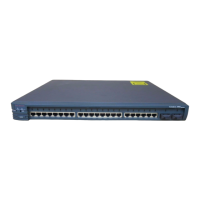Chapter 5: Layer 3 Interface Configuration 85
Section 5-6
3560 (config)# vlan 10
3560 (config-vlan)# exit
3560 (config)# interface gigabitethernet 0/1
3560 (config-if)# switchport mode trunk
3560 (config-if)# switchport mode on
3560 (config-if)# switchport trunk encapsulation dot1q
3560 (config-if)# interface vlan 10
3560 (config-if)# ip address 192.168.10.2 255.255.255.0
3560 (config-if)# no shutdown
3560 (config-if)# end
3560 # copy running-config startup-config
5-6: Routing Tables
■ To move packets between separate networks, the switching processor must have
knowledge of the destination network.
■ Networks that are connected to a physical or virtual interface are connected routes
and are automatically known by the switching processor.
■ You can configure the Layer 3 switching processor with statically defined routes by
entering the routes into the configuration file.
■ One of the most common ways to learn and maintain routes is to use a dynamic rout-
ing protocol, such as Open Shortest Path First (OSPF) Protocol or Enhanced
Interior Gateway Routing Protocol (EIGRP).
Configuration
1. Establish connected routes:
(interface) ip address address mask
By specifying a network address on an interface, you have also established an entry
for that network in the routing table. This step shows the configuration for an IP
address, but the same would hold true for other protocols (as shown in the section
“5-2: Layer 3 Ethernet Interfaces”).
2. Establish static routes:
(global) ip route network netmask {nexthop | interface} [admin-distance]
This command specifies a static route for the network using the mask specified. The
nexthop address or interface shows how to get to the network configured.
3. Enable dynamic routes:
(global) router protocol
(router)network network
The router command along with a protocol such as Routing Information Protocol
(RIP), OSPF, or EIGRP places you in router configuration mode. In this mode, you
specify the networks for which you want to run the protocol.
